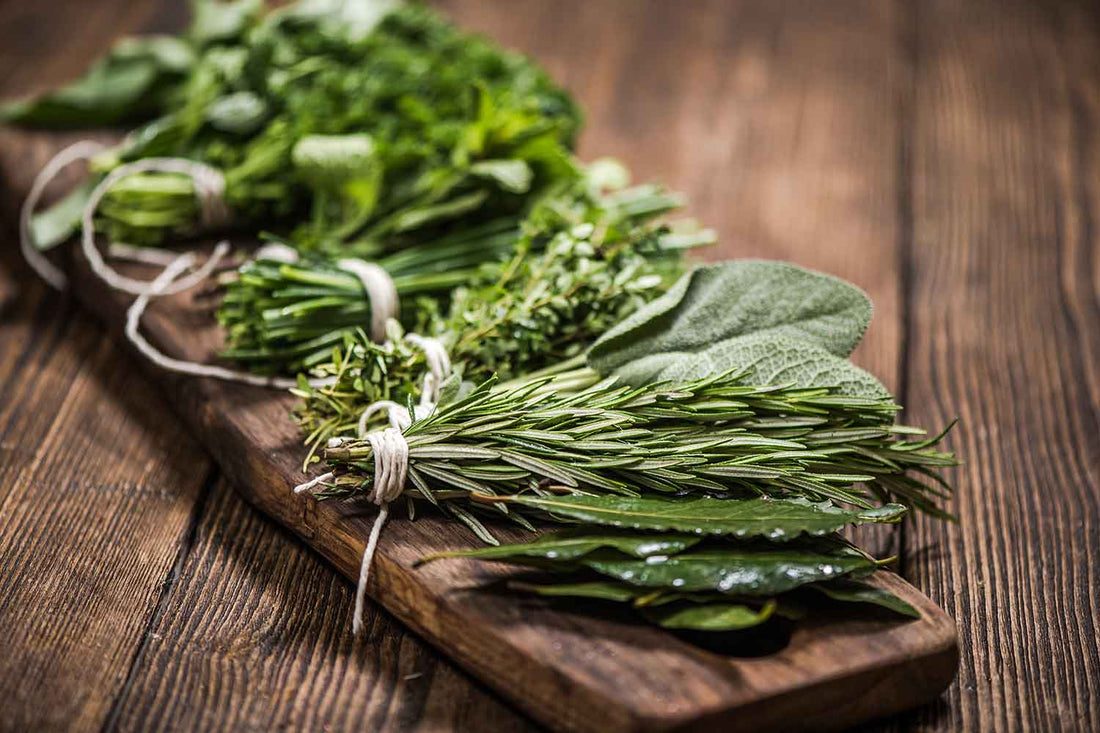What Herbs to Use When Cooking to Enhance Nutritional Value
Herbs have been a cornerstone of culinary traditions around the world for centuries. They not only add flavour and aroma to dishes but also come packed with numerous health benefits. Growing your own herbs can be a rewarding experience, providing fresh, organic additions to your meals. This blog explores various herbs, their culinary uses, health benefits, and tips on growing them.
1. Basil
Culinary Uses: Basil is a staple in Mediterranean and Southeast Asian cuisines. It is the star ingredient in pesto, adds freshness to salads, and enhances the flavour of tomato-based dishes like marinara sauce.
Health Benefits: Basil is rich in antioxidants, particularly eugenol, which has anti-inflammatory properties. It supports digestion, reduces stress, and has antimicrobial properties that help in fighting infections.
Growing Tips: Basil thrives in warm, sunny conditions. Plant it in well-drained soil and water it regularly, ensuring the soil stays moist but not waterlogged. Pinch off the flowers to encourage bushy growth.
2. Rosemary
Culinary Uses: Rosemary pairs well with roasted meats, particularly lamb and chicken. It also adds depth to soups, stews, and roasted vegetables.
Health Benefits: Rosemary is known for improving memory and concentration due to its carnosic acid content. It also has anti-inflammatory and antioxidant properties and can aid in digestion.
Growing Tips: Rosemary prefers a sunny spot with well-drained soil. It is relatively drought-tolerant once established. Prune regularly to maintain shape and promote growth.
3. Thyme
Culinary Uses: Thyme is versatile, used in everything from poultry and meat dishes to soups, stews, and marinades. It’s a key component of bouquet garni and herbes de Provence.
Health Benefits: Thyme has antiseptic and antibacterial properties. It is rich in vitamins C and A, promoting immune health. Thyme tea can soothe coughs and bronchitis.
Growing Tips: Thyme grows best in full sun and well-drained soil. It’s a hardy herb, tolerant of dry conditions. Trim regularly to prevent woodiness and promote new growth.
4. Mint
Culinary Uses: Mint adds a refreshing taste to salads, desserts, and beverages. It’s essential in Middle Eastern cuisine, notably in tabbouleh and mint tea.
Health Benefits: Mint aids digestion, alleviates headaches, and has antimicrobial properties. It’s also known to relieve symptoms of irritable bowel syndrome (IBS).
Growing Tips: Mint is an aggressive grower that can quickly take over a garden. It’s best grown in containers. It prefers partial shade and moist, well-drained soil.
5. Parsley
Culinary Uses: Parsley is a versatile garnish and an ingredient in sauces, soups, and salads. It’s an essential component of gremolata and tabbouleh.
Health Benefits: Parsley is rich in vitamins A, C, and K. It helps in detoxifying the body, supports bone health, and has anti-inflammatory properties.
Growing Tips: Parsley grows well in both full sun and partial shade. Keep the soil moist, and harvest the outer leaves first to encourage continuous growth.
6. Coriander (Cilantro)
Culinary Uses: Coriander is used in many global cuisines, from Indian curries and Mexican salsas to Middle Eastern dishes. Both the leaves (cilantro) and seeds (coriander) are used.
Health Benefits: Coriander aids in digestion, lowers blood sugar levels, and has anti-inflammatory and antimicrobial properties. It is also known to detoxify heavy metals from the body.
Growing Tips: Coriander prefers cool weather and can be grown in partial shade. It has a short life cycle, so succession planting is recommended for a continuous harvest.
7. Sage
Culinary Uses: Sage has a strong, earthy flavour that pairs well with rich meats like pork and duck. It’s also used in stuffing, sausages, and roasted vegetables.
Health Benefits: Sage improves brain function and memory, supports oral health, and has anti-inflammatory and antioxidant properties.
Growing Tips: Sage prefers full sun and well-drained soil. It’s a drought-tolerant plant that requires minimal watering once established. Prune regularly to maintain its shape.
8. Dill
Culinary Uses: Dill is often used in pickling, as well as in salads, soups, and seafood dishes. It’s a key ingredient in Scandinavian and Eastern European cuisines.
Health Benefits: Dill supports digestion, has antimicrobial properties, and is a good source of vitamins A and C.
Growing Tips: Dill prefers full sun and well-drained soil. It’s a tall plant, so ensure it has enough space to grow. Regular harvesting will encourage bushier growth.
Enhance the nutritional value with herbs
Herbs are more than just flavour enhancers; they are nutritional powerhouses that can elevate the health benefits of your meals. Incorporating herbs into your cooking not only improves taste but also adds a range of vitamins, minerals, and antioxidants to your diet. Boost the nutritional content of your dishes.
1. Basil
Nutritional Profile:
- Vitamins: Rich in vitamin K, essential for blood clotting and bone health.
- Minerals: Contains manganese, magnesium, and calcium.
- Antioxidants: Packed with eugenol, which has anti-inflammatory properties.
Usage Tips: Add fresh basil to salads, sandwiches, and smoothies to retain its nutrients. Incorporate it into cooked dishes like soups and sauces at the end of cooking to preserve its nutritional value.
2. Rosemary
Nutritional Profile:
- Vitamins: Contains vitamins A, C, and B6.
- Minerals: High in iron and calcium.
- Antioxidants: Rich in carnosic acid and rosmarinic acid, both known for their antioxidant properties.
Usage Tips: Use rosemary in marinades for meat and vegetables. Sprinkle chopped rosemary over roasted potatoes or vegetables to add a nutrient boost.
3. Thyme
Nutritional Profile:
- Vitamins: Excellent source of vitamins C and A.
- Minerals: Contains iron, manganese, and copper.
- Antioxidants: Rich in thymol, which has antimicrobial and anti-inflammatory properties.
Usage Tips: Add thyme to soups, stews, and casseroles. It can also be used to flavour roasted meats and vegetables.
4. Mint
Nutritional Profile:
- Vitamins: High in vitamin A and C.
- Minerals: Contains iron and manganese.
- Antioxidants: Rich in menthol, which has anti-inflammatory and digestive properties.
Usage Tips: Incorporate mint into salads, teas, and smoothies. Use it as a garnish for desserts and beverages for an extra nutrient kick.
5. Parsley
Nutritional Profile:
- Vitamins: Excellent source of vitamins K, C, and A.
- Minerals: Contains iron and folate.
- Antioxidants: Rich in flavonoids, which have anti-inflammatory and antioxidant properties.
Usage Tips: Use parsley as a garnish for soups, stews, and pasta dishes. Add it to green smoothies and salads for a nutrient boost.
6. Coriander (Cilantro)
Nutritional Profile:
- Vitamins: High in vitamins C, K, and A.
- Minerals: Contains potassium and manganese.
- Antioxidants: Rich in quercetin, which has anti-inflammatory and antioxidant effects.
Usage Tips: Add fresh coriander to salsas, salads, and guacamole. Use it as a garnish for soups and curries.
7. Sage
Nutritional Profile:
- Vitamins: Contains vitamins K and A.
- Minerals: High in calcium, iron, and magnesium.
- Antioxidants: Rich in rosmarinic acid, which has anti-inflammatory properties.
Usage Tips: Use sage in stuffing, sausages, and rich meat dishes. Add chopped sage to butter for a nutrient-packed spread.
8. Dill
Nutritional Profile:
- Vitamins: High in vitamins A and C.
- Minerals: Contains calcium, iron, and manganese.
- Antioxidants: Rich in monoterpenes, which have anti-inflammatory and antibacterial properties.
Usage Tips: Incorporate dill into salads, dips, and dressings. Use it to flavour fish dishes and pickles.
Practical Tips for Maximising Nutrient Intake
- Use Fresh Herbs: Fresh herbs generally retain more nutrients compared to dried ones. Incorporate them into your meals at the end of the cooking process to preserve their nutritional value.
- Combine Herbs: Combining different herbs can enhance both flavour and nutritional benefits. For example, a salad with parsley, basil, and mint provides a diverse range of vitamins and minerals.
- Grow Your Own: Growing your own herbs ensures you have a fresh supply year-round. Freshly picked herbs are at their peak nutritional value.
- Herb-Infused Oils and Vinegars: Infuse oils and vinegars with fresh herbs to create nutrient-rich condiments. Use these to dress salads or drizzle over cooked vegetables.
- Herb-Enhanced Smoothies: Add fresh herbs like mint, parsley, or basil to your smoothies for an extra nutrient boost. These herbs blend well with fruits and vegetables.
Growing Herbs at Home
Growing your own herbs can be both enjoyable and practical. Here are some general tips for a successful herb garden:
- Choosing the Right Location: Most herbs require plenty of sunlight, so choose a spot that gets at least six hours of direct sunlight each day.
- Soil Preparation: Well-drained soil is crucial. You can improve drainage by adding sand or organic matter like compost.
- Watering: Herbs generally prefer moist soil but be careful not to overwater. Allow the soil to dry out slightly between watering.
- Container Gardening: If space is limited, herbs grow well in containers. Ensure pots have drainage holes and use high-quality potting soil.
- Fertilising: Herbs do not need much fertiliser. A light application of a balanced fertiliser during the growing season is usually sufficient.
- Pest Control: Herbs are relatively pest-resistant. Encourage beneficial insects like ladybirds and avoid using chemical pesticides.
- Harvesting: Regular harvesting encourages new growth. For leafy herbs, pinch off leaves as needed. For herbs like basil and mint, prune the plants to keep them bushy.
Incorporating herbs into your cooking not only enhances the flavour of your dishes but also contributes to your overall well-being. Whether you’re a seasoned cook or a beginner, herbs offer a simple way to add complexity to your meals. Incorporating herbs into your cooking is an easy and delicious way to enhance the nutritional value of your meals. Each herb offers a unique profile of vitamins, minerals, and antioxidants.
By growing your own herbs, you can ensure a fresh supply year-round and enjoy the satisfaction of nurturing your plants from seed to harvest. Embrace the versatility and health benefits of herbs to elevate your culinary creations and support a healthy lifestyle.

